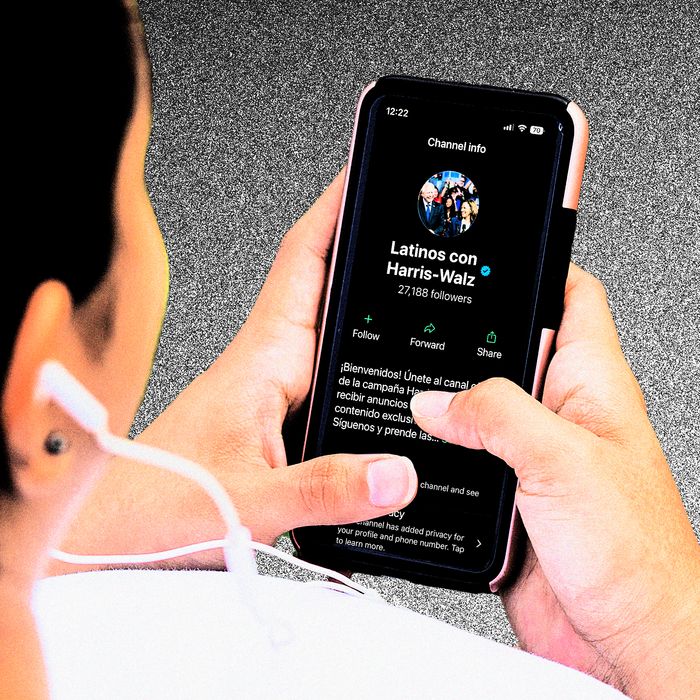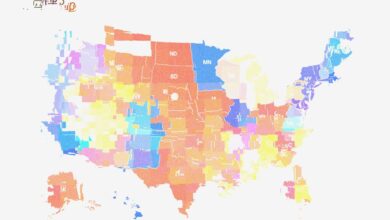

Photo-Illustration: Intelligencer; Photos Getty Images
When Tim Walz took a moment in his debate against J.D. Vance this month to quote scripture during an answer about immigration policy, some of Kamala Harris’s staffers back in Wilmington saw an unexpected opportunity. While much of the campaign was focused on rapid response, this particular moment had another destiny. Two days later, a 35-second clip of Walz, overlaid with Spanish subtitles, started circulating, complete with a Spanish caption: “el gobernador Walz habló sobre su fe y cómo ésta refleja los valores que guiarán a una administración Harris-Walz sobre los inmigrantes.” Governor Walz talked about his faith and how it reflects the values that will guide a Harris-Walz administration on immigrants. It wasn’t the campaign’s primary messaging out of the debate, or even on immigration. But it was starting to break through in one place: the campaign’s growing WhatsApp channel aimed at Latino voters.
As the campaign enters its final weeks, one area of significant agita for Democrats has been Harris’s standing with Latinos, especially those who’ve expressed less and less interest in engaging with politics. Though Democrats have long been able to count on Latino voters as part of their base, many have drifted away from the party, and toward Donald Trump, in recent years. Though Joe Biden won handily among Latino voters in 2020, Harris is still lagging with the group and pushing hard to make up ground in the final stretch of the race. With early voting open in many of the battleground states, Harris’s operation still has a relatively small footprint on WhatsApp. But as they search for hard-to-find voters in particular, they’re hoping to reach these final, possibly reluctant, Harris supporters by using the platform to engage their more plugged-in family and friends.
While WhatsApp isn’t traditionally a political tool in the U.S., unlike overseas, it’s a potent communication tool for a huge slice of the electorate. “We knew over 50 percent of Latinos are using WhatsApp and consuming news there — already naturally organizing, sharing family memes in their group chat, already using the space,” said Jaime Lopez, the campaign’s digital coalitions director, who runs the channel, referring to a Pew study from earlier this year.
Harris’s presidential campaign is the first of either party to use WhatsApp so directly. The idea hasn’t been to bombard their 27,000 followers in “Latinos con Harris-Walz” with appeals to vote or with nonstop ads, or even with memes. Instead, they’ve fed the channel a stream of graphics, videos, and articles designed to help start conversations among Latino families or friend groups, figuring that followers are likely already supporters, but that they will be willing to share the content with their networks — in some cases, very large ones. (The channel exploded in popularity after Carlos Eduardo Espina, an immigration rights activist with 10.5 million followers on TikTok and nearly 1 million on Instagram, directed his followers to it in September.) “We wanted to make sure folks had content accessible to forward to their family group chats and to encourage folks who might not feel comfortable having political conversations with their family to start it in this way,” Lopez told me earlier this month. A report from the Democrat-aligned Equis Research showed that WhatsApp is almost no Hispanic adult’s sole news source, including in Nevada and Arizona, but that its users are split evenly between foreign-born and U.S.-born Latinos and that it is a potent way to reach a wide variety of voters. “Latinos are pretty unique in the U.S., in that a lot of us are generationally connected in different ways to our Latino diaspora, and WhatsApp is one of those ways,” said Lopez. “I have relatives in Mexico and Spain and Colombia who only communicate this way. They might not know anything about Facebook or Twitter, but they sure know a lot about WhatsApp.” (The campaign has also launched channels focused on Arab American and Muslim voters, but those channels each have around 1,000 followers.)
The platform, which is owned by Meta, offers users few metrics with which to gauge their reach, but the campaign hopes its channel is helping spread Harris’s message beyond her more traditional-media and in-person appeals to Latino voters — especially in battleground states such as Nevada, Arizona, Pennsylvania, and North Carolina, where they represent significant parts of the electorate. Part of the calculus is that the app has become awash in right-wing conspiracies in recent years, and liberals have been slow to combat it.
Meanwhile, Democratic operatives have been registering alarm about the trend in openness to Trump among Latino voters, especially men, for four years, and Harris’s team launched their WhatsApp channel this summer after seeing both Mexican president Claudia Sheinbaum and Brazilian president Luiz Inácio “Lula” da Silva use the app to good effect in their own recent campaigns. But it’s just a small piece of Harris’s overall Latino outreach, which has cost tens of millions of dollars across television, online, and radio ads, in-person organizing, and repeated rallies and events, especially in Arizona and Nevada. On Thursday, Harris appealed directly to Latino voters at a Univision townhall in Las Vegas, continuing her practice of leaning far more heavily into economic messaging than previous Democratic presidential candidates, who usually focused on immigration to reach these voters. She has also been speaking more about housing and home care policies than she did in the early days of her candidacy, when she spoke more about her role as a prosecutor of gangs in a border state. And the campaign has been careful to try and target its appeals: it has hosted events and run radio ads specifically aimed at Puerto Rican and Dominican voters in Pennsylvania and Mexican Americans in Arizona, for example, and Harris has sat for interviews with prominent Latina radio hosts Chiquibaby and Angel Baby.
The WhatsApp channel fits into this appeal by acting as a message amplifier, though its tone is different than most of the campaign’s public communications. Lopez’s team launched the group this summer, coinciding with Harris’s convention in Chicago, with a selfie welcome video from campaign manager Julie Chávez Rodríguez. In recent days, it has shared graphics highlighting Harris’s new plan about home care for seniors, including highlighting how she cared for her own mother. And Lopez himself shared a Polaroid photo with his own mother, telling his own story of caring for his parents after his mother was diagnosed with cancer and suffered two strokes. Lopez’s message was in English, but like much of the content on the channel — including straight-to-camera appeals from Miguel Cardona, the education secretary, and actress Liza Colón-Zayas — the graphic describing Harris’s plan was shared in both English and Spanish.
“The good thing about the Harris campaign is it has been a control-alt-delete reset the party needed, particularly with efforts engaging Hispanic voters,” said Fernand Amandi, a Democratic pollster who advised Barack Obama’s campaigns on Latino outreach. “It would’ve been nice for this to be more actively engaged months ago. But it’s better to be late to the party than to miss it entirely.”
WhatsApp is also where the campaign is boosting content that it wants to make sure penetrates to Latino women who might not be following political news closely. Earlier this month the channel featured an ad focusing on Yesenia Gámez, a military wife from Tucson who is trying to conceive via IVF and is worried about being transferred to a state with a Trump-inspired IVF ban.
None of it has been enough to calm Democratic nerves, especially when it comes to younger Latinos. The campaign hopes to reach them through their families, knowing it is unlikely to get them through more traditional methods like television or radio. On Thursday, the WhatsApp channel advertised Harris’s Univision appearance, linked to information about Project 2025, and shared the candidate’s statement on the latest court wrangling over Dreamers. In recent weeks the campaign has also increased its advertising push to find otherwise disengaged Latino voters, but it hasn’t stopped whispering among some operatives who want to see more of a robust surrogate program in the battlegrounds, in particular.
Such concerns are inevitable in a race likely to be decided by mere thousands of votes in just a handful of states. Still, the campaign has found that some of its most successful pieces of content on the platform are “very off-brand, that don’t look like they come from a campaign,” said Lopez. “They look like your aunt or cousin made it, that’s what we want to emulate here.” He pointed to a September image featuring Harris’s first name written out in purple and surrounded by butterflies — with no political message at all.
Source link




